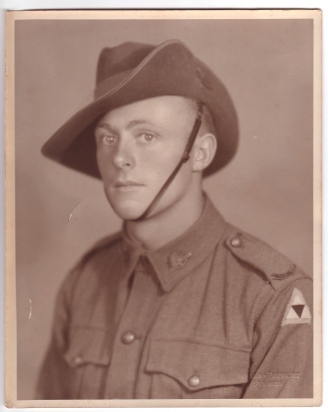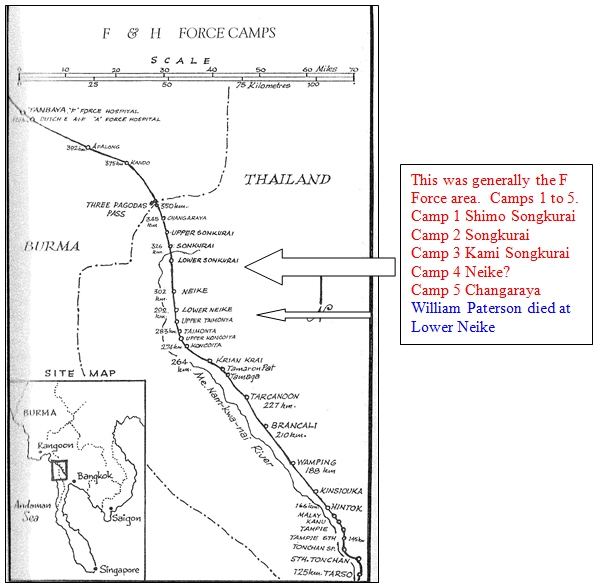 |
 |
![]()
| WILLIAM JAMES PATERSON WX9073 CORPORAL |
| 2/4 MACHINE GUN BATTALION 1916 - 1943 |
WILLIAM JAMES PATERSON was born in Berwick Victoria March 1, 1915. He was the first of five children to William James (1st) and Jessie (nee) Harrison.
William left the Moyarra farm c1936 and settled in Western Australia (W.A.). He worked as a timber feller at various timber mills in the South West of W.A. William was a champion axe man and won a number of competitions. William met Hope Briggs at a timber mill, possibly at Mornington WA. William and Hope were married on June 24, 1940. They had two children. William John and Penelope Anne.
 |
William enlisted in the AIF (Australian Imperial Forces) for military service in WW2 on Oct 2, 1940. After basic training he was allocated to the 2/4 Machine Gun Battalion in training at Northam WA on Nov. 27, 1940. As a training exercise, the Battalion did a Forced March from Northam to Perth. They left the Northam Military Camp, March 4, 1941 and initially, marched 72 km in just 2 days. The column's final bivouac was at Bassendean Oval. The following morning the march took the column to Perth Oval where the troops changed into clean uniforms. Then in full marching order, with fixed bayonets, the Unit with the Commanding Officer (C.O.) Lt Colonel M.J. Anketell at the head, marched into the city. The Unit received a rousing reception on their march through the city. In July 1941 the Battalion moved to Woodside in SA by two different modes of transport. Portion of the battalion went by ship (MS Katoomba) leaving Fremantle on the July 12. Other elements followed by train. Still later, others were moved by ship (MV Duntroon). William actually left by train on July 13, 1941 bound for the Woodside camp for further intense training. William was promoted to Corporal on Oct 6, 1941. |
While at Woodside camp, William and his mate Joe Pearce WX9268 took leave and went to Melbourne Victoria. William visited the family farm at Moyarra South Gippsland and also caught up with his uncle Colonel Alexander Thomas Paterson in Ormond Melbourne. Alexander Paterson was the C.O. of the WW1 39th Battalion. On that same weekend Joe Pearce went to the 1941 VFL Grand final.
Just before William left for Woodside in July 1941, Hope with her two children went back to live with her parent's Robert and Catherine Briggs at Mornington WA. Hope, a trained nurse, became Matron of the Mornington Hospital.
After further training at Woodside the Battalion moved by train to Alice Springs and then by truck to Darwin. The Battalion embarked from Darwin on Dec. 30, 1941 in a number of small steamers. William was on the SS Marella. The task force sailed to Port Moresby where the Battalion was loaded onto the Aquitania. The Aquitania then sailed for Sydney picking up more troops from 2/18, 2/19 and 2/20 Battalions, being part of 22nd Aust Bde. The Aquitania then went to Fremantle and anchored in Gauge Roads. No troops were given "shore leave'. However, many hitched rides on supply lighters (which were servicing the vessel) to Fremantle and went AWOL. After one day at Fremantle the ship sailed on Jan. 16, 1942. Later, a number of NCOs were charged and reduced to the rank of private for disobeying orders. William too was demoted to private. (It is worth noting, that NCO ranks were reinstated on Feb 11 1942, as there was a shortage of non-commissioned leadership). Of the 200 "ship jumpers" left behind when the ship sailed, 88 ended being temporarily held in Fremantle Jail.
Taken aboard the Aquitania at Fremantle was Trevor Lloyd Ainsworth, No.1 company AASC as a reinforcement from Northam camp. Trevor was a nephew by marriage to William. Trevor Ainsworth died on the second Sandakan march June 9, 1945. It is not known whether he died or was killed by the Japanese. One wonders! It is worth noting that in Lynette Silver's book "Sandakan - A Conspiracy of Silence" she makes mention of an event on the same date.
The next stage of the journey was to the Sunda Straits where the Battalion and other troops were offloaded onto three Dutch streamers (cattle boats). William was aboard the Van Swoll. This change of ships was implemented because of the risk of the Aquitania being trapped in Keppel Harbour Singapore. On Jan. 26, 1942 the Battalion arrived in Singapore. As part of the defence of Singapore 13 Platoon (of 2/4 MG Bn) set up their machine guns on Singapore's north shore near Lim Chu Kang Road in support of the 2/20 Infantry Battalion. The three machine guns were deployed either side of a jetty with a rotunda at the end. (In 2009 the jetty is still there, with the Rotunda replaced by a house).
The Japanese commenced shelling from the Malaysia mainland across the Johore Strait on 8 Feb. During the barrage the machine gun crew retreated to the safety of a trench around midday. A direct hit saw Sgt Joe Pearce buried up to his waist. No. 3 gunner Bobby Pratt (WX8705) was killed (Pratt's name is inscribed on the Memorial at the Kranji Cemetery, in Singapore). William Paterson was severely wounded. He sustained a shattered right elbow and further injuries to face and shoulder, requiring plastic surgery. He was hospitalized for 8 months as a prisoner of war. For the bulk of the time he was in the Allied Australian General Hospital at Roberts Barracks. He was treated by Lt Colonel William Bye NX70581 (NSW Medical Officer). Following the treatment William's arm could no longer be flexed. Capitulation by the Allies to the Japanese took place on Feb. 15, 1942. Accordingly, William was incarcerated as a POW whilst still a patient.
In April 1943 William volunteered to go with the 7000 strong "F" Force to Thailand. They went in the false belief, from Japanese propaganda, that conditions would be better than at Singapore. They then moved by train (rice trucks). The journey took 4 nights /5 days. On arrival at Banpong in Thailand the men of "F" Force were marched 300 km over 18 days. The march took place, mostly at night, to avoid the intense heat. The monsoon season had commenced with heavy rain and often they were marching with their feet sinking into the muddy track.

While on the line William, even with his handicapped right arm, still exhibited some of his axeman's skills, by showing fellow POWs how to adze sleepers,
William died peacefully July 25, 1943 aged 28 at the camp Shimo (Lower) Neiki (below the arrow in the above map) of Cerebral Malaria and Colitis. The area was rife with cholera. Accordingly, most bodies were cremated. His ashes then were taken about 20 km north for burial at the camp Sonkurai (No. 2 camp on the bank of the Sankalia River) in Thailand. After the war the remains of soldiers who died beyond the half way point on the railway, including Sonkurai, were taken to a major War Cemetery at Thanbyuzayat at the northern end of the railway in Burma.
Written by his son Bill Paterson, Merriwa WA 6030 in 2010, with some minor assistance from Peter Winstanley.
|
|